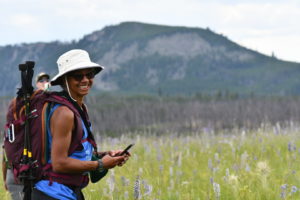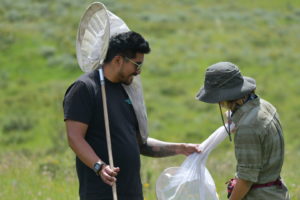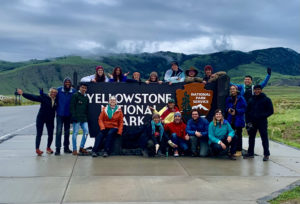
Colorado State University Ecosystem Scientist Gillian Bowser’s entire career has been focused on pollinators and their powerful role in our ecosystems. Her important work began at Yellowstone National Park and continues there today.
Bowser, an associate professor in the Ecosystem Science and Sustainability department in the Warner College of Natural Resources and research scientist at the CSU Natural Resource Ecology Lab, earned her master’s degree from the University of Vermont in the 1980s where she completed research at Yellowstone National Park.

“Back then, I had to do my research on something the park was interested in since they were supporting my work,” said Bowser who heads the Bowser/Halliwell lab at CSU, a lab that has three main areas of research: pollinator loss in national parks and protected areas, diversity and inclusion in natural resources and international environmental negotiations.
During her graduate work at Yellowstone, Bowser found a mentor in Mary Meagher one of the National Park Service’s first female biologists. Meagher, who had started work at Yellowstone in 1952 and studied bison, suggested Bowser explore the park’s elusive and unknown pollinators.
“Mary said, ‘We know a lot about bison, and we know a lot about bears, but we don’t know anything about butterflies,’” Bowser said. Meagher encouraged Bowser every step of the way in what became her life’s work, the study of pollinators as ecosystem indicators of the health of parks and other protected areas. “I can’t emphasize enough how much a mentor Mary became to me. She adopted this African-American kid from inner city Brooklyn to do some pretty wild research in Yellowstone.”
Bowser said, at the time, butterfly knowledge in Yellowstone was an “enormous black hole of research.” In fact, the park’s Chief of Interpretation had told Bowser upon her arrival that there were few to no butterflies in the park. Bowser has since found that Yellowstone is home to 400 species of butterflies and 30 of those species are blue butterflies, butterflies in the family of Lycaenidae and have more butterflies listed as endangered than any other group of butterflies
On Meagher’s suggestion, Bowser’s Yellowstone research was conducted in Cougar Creek, an off-the-beaten-trail and unvisited meadow in the western part of Yellowstone that is sagebrush dominated and has the largest wildflower bloom in the park with “lupines and wild geraniums reaching above the knees.” At Cougar Creek, Bowser studied the changing phenology of butterflies and plants and her collection of butterflies is part of the Yellowstone Heritage Center, an archival repository for Yellowstone National Park located in Gardiner, Montana.
Returning to study Yellowstone’s pollinators

Gillian was later hired as a wildlife ecologist through the National Park Service in 1984, leaving Yellowstone in 1991 but continuing her work at other National Parks before coming to Colorado State University in 2009. Bowser revisits Cougar Creek each year, taking with her CSU students through a program called the Rocky Mountain Sustainability in Science Network and her Ph.D. student continues her work, documenting phenology and changes in pollinators in national parks.
“I take my students to my old research site because it became my special, secret place, a place of knowing that nobody else knew about in this park,” Bowser said. “It’s a really incredible part of Yellowstone that nobody goes to that I love to be able to share with students.
“Now through pictures and citizen science, we can give the general public a glimpse of the incredible diversity of pollinators in one of our nation’s oldest parks.”
What Bowser, her Ph.D. student Sarah Whipple and her other graduate students have witnessed over the years is a change in climate, namely the lack of snow in the meadow earlier in the year, changing the bloom season. She and her students have gone on to study how these dramatic changes affect the park’s pollinators at other sites including high elevation plateaus. Her butterfly research from Yellowstone dating back to the 80s is now utilized to show changes in phenology over time.
“It’s been a great way to be the front end of climate change because we can now map all these changes and adjustments that are going on in this one meadow.” Bowser said noticing these changes over time and how they affect pollinators are critical to understanding how species can survive and thrive in a changing climate.
“Understanding these shifts is so important for us to protect pollinators in the long run because they’re little, tiny guys. They’re hard to see sometimes, but they perform such a critical service for us in terms of our food crops and agricultural systems as well as the preservation of our national parks, yet we pay very little attention to what’s happening to them regarding climate change.”
Learn more about Bowser’s pollinator research at the Bowser/Halliwell Lab website.